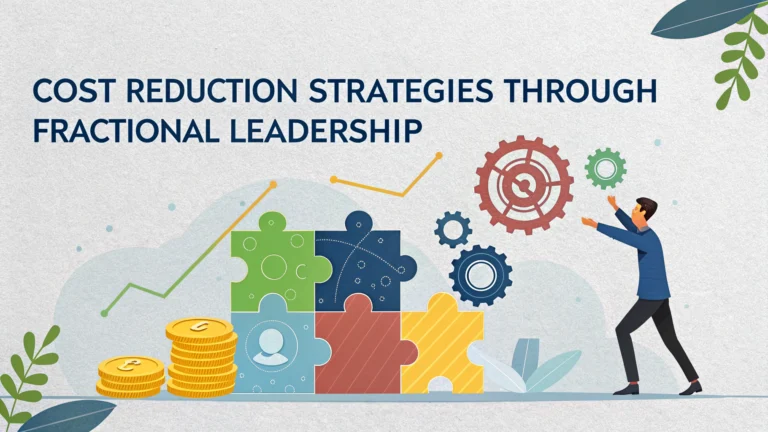Fractional leadership offers businesses a strategic way to access high-level executive expertise without the substantial costs of full-time C-suite hires.
Small and medium-sized businesses often struggle to afford experienced executives, yet they need strategic guidance to grow and optimize operations.
This quick guide explores how organizations can leverage fractional COO services to reduce costs while maintaining operational excellence.
Understanding Fractional COO Cost Benefits
- Elimination of full-time executive salary and benefits packages
- No long-term employment commitments or severance obligations
- Flexible engagement terms based on business needs
- Access to diverse industry experience at a fraction of traditional costs
Typical Cost Savings Breakdown
| Expense Category | Full-Time COO | Fractional COO |
|---|---|---|
| Annual Salary | $150,000 – $300,000 | $60,000 – $120,000 |
| Benefits Package | $30,000 – $60,000 | $0 |
| Office Space/Equipment | $5,000 – $15,000 | Minimal to None |
Strategic Implementation Approaches
Start with a needs assessment to determine the exact scope of fractional COO services required.
- Project-Based Engagement: Hire for specific initiatives or transformations
- Part-Time Ongoing: Regular but limited weekly hours
- Advisory Role: Periodic consultation and oversight
- Hybrid Model: Combination of remote and on-site presence
Maximizing ROI with Fractional Leadership
Focus fractional COO efforts on high-impact areas that directly affect the bottom line.
- Process optimization and efficiency improvements
- Technology implementation and automation
- Team restructuring and development
- Vendor management and cost control
- Performance metrics and KPI tracking
Finding the Right Fractional COO
Look for professionals with proven track records in your industry and specific operational challenges.
- Check references and past success stories
- Evaluate industry-specific experience
- Assess communication style and cultural fit
- Review their network and resources
Implementation Timeline
- Initial assessment (1-2 weeks)
- Strategy development (2-3 weeks)
- Implementation planning (1-2 weeks)
- Execution and monitoring (3-6 months)
- Evaluation and adjustment (ongoing)
Making the Most of Your Investment
Set clear expectations and deliverables from the start of the engagement.
- Establish specific goals and metrics
- Create detailed communication protocols
- Define decision-making authority
- Schedule regular progress reviews
Next Steps for Implementation
Contact professional organizations like COO Alliance or Chief Executive Peer Organizations to begin your search for qualified fractional COOs.
Consider scheduling introductory calls with multiple candidates to find the best fit for your organization’s needs and culture.
Begin with a small pilot project to test the working relationship before committing to a longer-term engagement.
Risk Management Considerations
Establish clear protocols and agreements to protect business interests when engaging fractional leadership.
- Confidentiality agreements and NDAs
- Intellectual property protection
- Clear termination clauses
- Performance benchmarks and accountability measures
Technology Integration
Leverage digital tools to maximize fractional COO effectiveness and remote collaboration.
- Project management platforms
- Virtual meeting solutions
- Cloud-based document sharing
- Performance tracking software
Common Implementation Challenges
Internal Resistance
- Employee skepticism of external leadership
- Communication gaps
- Cultural integration issues
Operational Hurdles
- Knowledge transfer limitations
- Time zone coordination
- Decision-making delays
Transforming Operations Through Strategic Leadership
Fractional COO services represent a powerful solution for organizations seeking executive-level expertise without traditional cost barriers. Success depends on careful planning, clear communication, and strategic alignment with business objectives.
- Document lessons learned for future engagement optimization
- Build scalable processes that outlast the engagement
- Maintain flexibility to adapt as business needs evolve
- Focus on knowledge transfer to internal teams
By following these guidelines and maintaining a strategic approach, organizations can maximize the value of their fractional leadership investment while building stronger operational foundations for sustainable growth.
FAQs
- What is fractional leadership in the context of cost reduction?
Fractional leadership involves hiring experienced executives on a part-time or contract basis, allowing companies to access high-level expertise without the full-time salary and benefits costs of traditional executive positions. - How does a fractional COO help reduce operational costs?
A fractional COO identifies inefficiencies, streamlines processes, optimizes resource allocation, implements cost-effective solutions, and manages operational improvements while only charging for the time actually needed by the organization. - What percentage of costs can companies typically save with fractional leadership?
Companies can save 40-70% compared to hiring a full-time executive, as they only pay for the actual hours worked and avoid expenses like benefits, bonuses, and stock options. - What industries benefit most from fractional COO services?
Small to medium-sized businesses, startups, scaling companies, and organizations in transition phases benefit most, particularly in technology, manufacturing, healthcare, and professional services sectors. - How long is a typical fractional COO engagement?
Engagements typically range from 6-18 months, with the COO working 8-20 hours per week, depending on the organization’s needs and specific projects. - What specific cost reduction strategies do fractional COOs implement?
Fractional COOs implement vendor management optimization, workforce planning, process automation, supply chain improvements, operational restructuring, and technology integration to reduce costs. - How do companies measure the ROI of a fractional COO?
ROI is measured through reduced operational costs, improved efficiency metrics, increased productivity, streamlined processes, and specific cost-saving initiatives implemented during the engagement. - What are the risks of using fractional leadership for cost reduction?
Risks include potential knowledge gaps during transition periods, cultural adaptation challenges, and the need for clear scope definition, though these can be mitigated through proper planning and communication. - How quickly can organizations expect to see cost reductions with a fractional COO?
Initial results typically appear within 60-90 days, with significant cost reductions realized within 4-6 months as strategies are implemented and optimized. - Can fractional COOs work alongside existing leadership teams?
Yes, fractional COOs are experienced in collaborating with existing leadership teams, providing complementary expertise while respecting established organizational structures and relationships.








